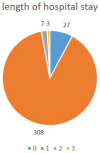A retrospective observational cohort study evaluating the postoperative outcomes of intracapsular coblation tonsillectomy in children
- PMID: 36477138
- PMCID: PMC9729299
- DOI: 10.1038/s41598-022-25768-0
A retrospective observational cohort study evaluating the postoperative outcomes of intracapsular coblation tonsillectomy in children
Abstract
Coblation intracapsular tonsillectomy (ICT) is becoming popular due to its decreased postoperative complications. However, a concern exists about the need for revision surgery. We conducted a retrospective observational cohort study, with a null hypothesis that Coblation ICT is not associated with recurrence of the preoperative symptoms, obstructive tonsillar regrowth, or the need for revision tonsillar surgery. We reviewed 345 patients (median age of 4.5 years; IQR 3.2-6.3), operated by the senior author between Feb 2017 and Sep 2020, for a median follow-up of 395.0 days (IQR 221.5-654.5). Most patients had snoring (94.2%), mouth breathing (92.8%), restless sleep (62.6%), and sleep disorder breathing (52.8%); 12.5% had recurrent tonsillitis. The mean initial total symptoms score (TSS) was 5.2 (SD 1.4, range 1-8); 87.5% had three or more symptoms; 86.7% underwent ICT; TSS decreased postoperatively to a mean of 0.2, SD 0.8, range 0-7. The mean hospital stay was 0.96 day (SD 0.36, range 0-3). Secondary bleeding occurred in 0.7% of ICT patients. No patient required admission or intervention. There was no documented tonsillar regrowth resulting in upper airway obstruction. No one needed tonsillar revision surgery. Intracapsular tonsillectomy was shown to be an effective procedure with long-lasting results.
© 2022. The Author(s).
Conflict of interest statement
The authors declare no competing interests.
Figures





References
-
- The National Prospective Tonsillectomy Audit. Final Report. Royal College of Surgeons of England (2005). https://www.rcseng.ac.uk/-/media/files/rcs/library-and-publications/non-...
Publication types
MeSH terms
LinkOut - more resources
Full Text Sources

